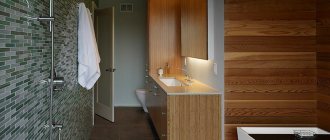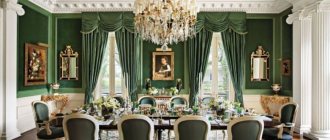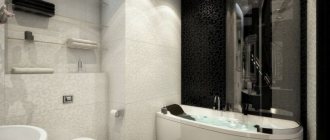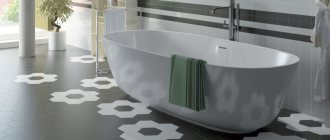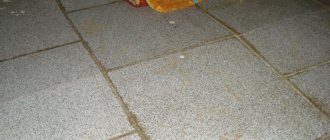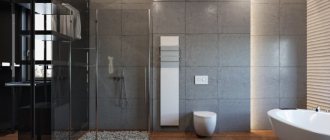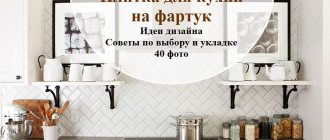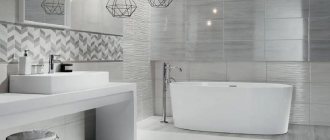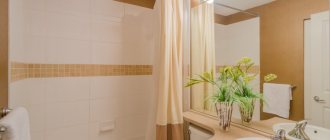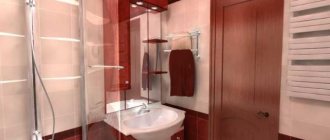Features of wood-look tile design
- In order for the floor covering to be especially reliable, it is better to choose more durable products with a matte surface. If ceramics are used, it must have a high level of moisture resistance and anti-slip properties.
- When choosing grout, its color does not have to match the tone of the tile. Contrasting seams will further highlight the appearance of the finish and make it more impressive.
- When decorating a small bathroom, you should use cladding in light colors, for example, ash, maple or bleached oak with almost imperceptible relief. This way you can add visual space to the room.
Where to use tiles
The material has been chosen, the color scheme has been determined, all that remains is to draw up a design plan. What is better to tile in the bathroom?
Perhaps the most popular option is wall tiles.
- Here your imagination is unlimited, it will be very easy to care for such walls, and you will be very pleased with the appearance.
- If you're tired of dull, monochromatic tiles, it's time to decide on a new design. Flooring options are also worth considering.
- It is better to choose porcelain tiles - they are the most durable. Visually, your bathroom floor will look like parquet.
- The wood-look design also looks great on the tabletop - aesthetics and neatness are guaranteed.
If you want your shower to look like a sauna, original tiles will do a great job with this design. Decorate the pallet with rectangular tiles so that it imitates parquet.
You can decorate the bathroom screen with dark tiles that imitate exotic wood species, or you can choose a lighter color scheme, then the atmosphere will be more comfortable and warmer.
Glazed ceramics are an excellent option for finishing the ceiling - a protective layer will protect the material from exposure to steam and moisture.
Which tile is better to choose for the bathroom?
Several types of tile finishes:
- Ceramic (tile). In its production, natural materials are used, such as clay and sand with the addition of special components that improve the structure. There are unglazed and glazed tiles, which have a longer service life, durability, resistance to ultraviolet radiation and temperature changes.
- Porcelain tiles. It can perfectly imitate any type of wood and is quite durable and resistant to low temperatures. The composition of porcelain stoneware includes white clay and sand with natural dyes.
- Quartz vinyl. The main component of such facing tiles is quartz sand with the addition of various impurities. The tile has a certain flexibility and a high degree of comfort, as it is quite warm.
How to choose?
The choice of ceramic tiles must be approached responsibly, studying in detail the properties and technical characteristics of the material.
When purchasing the necessary material, you need to know what type of tiles will be needed for this type of work:
- Majolica is a tile obtained through a pressing process and coated with an opaque glaze. It has high strength and resistance to aggressive compounds.
- Terraglia is a material that undergoes two firings and is covered with a layer of glass glaze.
- Cotto is a tile that has a bright texture and a unique texture of natural materials.
- Ceramic granite is used to cover floors with an increased level of load.
- Clinker is processed at high temperatures and is used in rooms with high humidity.
Technical documents are important, in which the manufacturer must describe in detail the characteristics of the material:
- percentage of water absorption;
- level of wear resistance;
- actual tile caliber;
- color spectrum;
- frost resistance indicator;
- degree of resistance to chemical compounds.
A huge assortment of products in modern construction stores can lead novice craftsmen to the wrong choice of the necessary material. Experts advise seeking help from consultants at retail outlets or independently studying all the intricacies and properties of tiles. Only with a complete amount of information can you purchase a quality product that will help implement all your planned projects.
Wood in the bathroom interior
Wood is the most common finishing material. Its color, texture and warmth will never go out of style. Most modern people have difficulty imagining its combination with water, considering the combination incompatible.
The materials we are used to (metal, tiles, plastic, ceramics) began to be used relatively recently, although earlier humanity used wooden troughs, barrels, and tubs for centuries. Today, such bathroom interiors and other natural attributes are again becoming in demand.
The assumption that wood is not the most optimal material for a bathroom is irrelevant today. Modern processing methods make it possible to create a quality that is completely resistant to water. And for those who continue to doubt, there is the possibility of using analogues: tiles, stone, PVC.
Materials stylized as wood
To create an unusual bathroom interior, the log house is most suitable. Due to the high cost, many people replace it with tiles and wood-colored panels. Ceramic tiles that imitate parquet are suitable for finishing the floor. She is not afraid of moisture and mold.
The block house looks great, but it “eats up” precious meters in the bathroom, so it is used only in rather large rooms.
The moisture-resistant lining looks good; shelving is also made from it. If your budget allows, porcelain stoneware finishes like laminate, stone or concrete will last quite a long time.
In order to save money and not to bother with surface care, a rational interior solution would be to use wood only as an additional finishing element or only for shelves and cabinets.
Among the alternative materials that successfully combine or replace wood are PVC panels. They will not last so long, but they are inexpensive, easy to install, do not require putty, and are varied in color, including wood-look, moisture-resistant plywood boards with veneer finishing.
Solid boards for covering bathroom floors are mainly made from hardwood, ready for installation, and will not require additional protective treatment. Three-layer parquet boards are equally popular. They are easy to install and go well with stone and ceramics.
One of the new products is wall linoleum. It is made from polyurethane fiber, on top of which watercolor images are applied. Glue it to the wall with special glue after preliminary leveling the surface. The raw materials have high moisture resistance and a wide selection of colors.
A cheaper material that is not afraid of moisture is moisture-resistant wood-look wallpaper. Repair work is carried out quickly, but they will have to be changed often due to rapid wear and possible development of fungus.
Features of using natural wood in the bathroom
A bathroom is a damp room that places specific demands on the quality of finishing. On the one hand, you need it to be warm and comfortable. In this case, it is better to use natural wood. But due to dampness, the material is susceptible to accelerated rotting, mold and deformation. Certain types of wood are resistant to this effect:
- elm;
- beech;
- bamboo;
- teak;
- cedar;
- ash.
Therefore, when purchasing, attention is paid to the quality of the material, breed and correct processing.
Important! Each wooden element must be treated with special compounds that protect the coating from exposure to dampness.
The nuances of processing wood that will be used in the bathroom:
- The wood must be sanded, impregnated with an antifungal compound, varnish or special wax.
- If desired, you can go over the surface with stain; this product changes the color of the coating.
- If natural material is oiled, it will become more resistant to mechanical damage and acquire some shine.
In a small bathroom it is better to use light-colored wood.
Below are interesting ideas, photos and valuable tips for decorating a bathroom.
If we choose wood-look tiles: finishing and material features
For most of us, tiles are the optimal, and most importantly, unpretentious option for finishing a wet room. Thanks to a wide variety of textures and colors, you can achieve an incredible interior. Using a unique alternative cladding method, it is quite possible to realize a wide variety of ideas.
The most common types of tiles used for bathrooms are 3 types:
- Ceramic (tile) - made of clay, sand and binding elements. There are two types: unglazed and glazed, characterized by a long service life.
- Porcelain tiles are the perfect imitation of wood. The composition includes white clay, sand and dyes.
- Quartz vinyl tiles, which contain quartz sand and connecting friction clutches. It has relative flexibility, heats up quickly, which can be considered the best option for a floor equipped with a heating system.
Laminated wood:
- high-quality laminated panels do not deform over time, do not “swell” at the edges, so there are no gaps between them;
- may have higher strength and wear resistance;
- they usually have a moisture protection system, making them an ideal choice for the bathroom; they are covered with special wax;
- laminated boards also have an antistatic surface, thanks to which dust does not settle on them, which makes cleaning easier;
- it is also the cheapest solution - much cheaper than solid wood planks.
Natural wood:
- walking barefoot is much more pleasant than walking on laminated panels, warmer and more pleasant to the touch;
- has natural sound insulation that will work in any interior, not only in the bathroom;
- it also has hygroscopic properties, which means that it collects excess moisture from the air, and when it becomes too dry, it releases it;
- helps maintain the proper microclimate in the apartment, and this helps improve the mood of the people living in it;
- less resistant to impacts than laminated boards, but if damaged they are much easier to repair;
- real wood ages very gracefully - it will look impressive.
- However, it is more expensive than laminated panels and, in addition, if you want to choose the right planks for the bathroom, you must choose wood with certain properties and with a lot of natural oils. It is also important to properly saturate the wood.
Wood for the bathroom - wood floors
Wooden bathrooms are designed in different ways, depending on homeowners' preferences, trends, and available materials. One way to give your space a pleasant climate is with wood tiles for the bathroom. Are you wondering if this will really work?
There are many types of ceramic tiles on the market today that look like wood. A bathroom with imitation wood flooring still looks impressive. Such wood in the bathroom is resistant to moisture and, above all, environmentally friendly.
The combination of the comfort and hygiene of tiles with the warmth and aesthetics of wood is attracting more and more fans, and this does not surprise us at all! If you also want to maintain the warmer properties of wood than ceramic, you may want to consider underfloor heating in your bathroom.
Another solution instead of wooden tiles for the bathroom, or rather wood-like ones, are solid boards on the floor. Multi-layer wood is not suitable for humid environments. When choosing a tree, you must first of all pay attention to its parameters. It is important that it deforms as little as possible from water and is resistant to moisture. Foreign oak varieties are good: teak, iroko, merbau, dussy and paduk. They have more oil, which protects the wood from moisture, which is why it is often used when creating bathroom designs.
Variety of colors
A wooden bathroom design will not become cozy if you do not follow certain rules during the renovation process. When choosing a color palette:
- do not choose too dark shades;
- do not overuse flashy colors;
- the bathroom is the only room in the house where the color scheme of the ceiling and walls can be done in a single key.
Contrasting color combinations are applicable in the bathroom. The combination of light and dark, the combination of muted and bright is always effective. As a rule, one or two tones predominate, the rest only complement them.
It is better to decorate the sanitary room in tones that are opposite in color, warm and cold. If you want to make the situation lighter, achromatic, use gray or form structural surfaces.
The combination of gloss and matte coatings looks interesting, which can be emphasized by the daylight penetrating into the room passing through the frosted, corrugated glass.
The color of the bathroom ceiling is of paramount importance; tinting it makes the most favorable impression. Walls overloaded with decor require a neutral floor color.
Wooden bathroom - the right combination of materials
When choosing a wooden bathroom, it's worth thinking about interesting combinations of materials that will add charm to the room. Wood is generally a very elegant material because not only does it work beautifully in any style: modern, Scandinavian or classic, but it also looks good with most colors and materials.
A bathroom made of wood and stone will be interesting. The stone itself can look quite heavy in an interior, but adding wood to a bathroom like this will soften the harsh expression of the stone and give the room a warmer, more inviting feel. The bathroom made of concrete and wood is amazingly beautiful. The coolness of concrete will be ideally broken by wooden elements - be it walls or wooden bathroom furniture.
Marble and wood for the bathroom: types of materials
On the market of finishing materials for bathrooms you can find marble and wood of various varieties and colors. Which ones are used most often in interior design?
The combination of wood and marble in the interior of the bathroom
Marble stone color options
As mentioned above, marble stone can be natural or artificial, imitating natural stone in color and texture. What shades are found in this material?
Combination of marble of different colors in the bathroom interior
1. White . The most common color of this stone. A universal solution that is suitable for bathrooms of any size - it will visually enlarge small ones, and add lightness and a feeling of spaciousness to large ones. Refreshing, delicate, airy, white marble will be the ideal backdrop for both classic and modern minimalist bathrooms. In the first case, choose options with golden brown and pinkish splashes, and in the second, with dark gray ones.
White marble bathroom decoration in minimalist style
White marble in a Scandinavian style bathroom
White marble in the interior of a classic style bathroom
2. Black . The dramatic, brutal and incredibly stylish look of marble stone. In small bathrooms it is better to use it as a small accent, but in spacious ones it can be a solo feature. An effective solution for classics and art deco, but also suitable for modern style. Black marble in the bathroom goes well with chrome and gold plated details.
Black Marble Countertop in Art Deco Bathroom
Black marble accent wall in bathroom
Bathroom interior with black marble in a modern style
Decorating a bathroom with black stone requires carefully thought-out lighting: the more light sources in the room, the more comfortable it is to be in it and the more interesting the visual effects on the surface of the finishing material.
Decorating a bathroom with black marble requires good lighting
3. Gray . The same universal option as white. Looks great in monochrome bathroom interiors - black and white or completely in gray shades. A fresh solution for the minimalist style, especially if you complement the design with wood in light colors. Gray marble also pairs beautifully with black fixtures and raw concrete elements.
Gray marble finishing in a minimalist bathroom
Gray marble in bathroom interior decoration
Monochrome bathroom interior with gray marble trim
4. Brown . Brown marble with pale beige veins is the most practical option for finishing stone: stains and stains are practically invisible. This material is ideal for bathrooms in warm beige-brown tones: just combine it with wood in a natural shade and gold. Brown stone is an original solution for a bathroom in a classic or art deco style.
Brown marble countertop in a monochrome bathroom interior
Bathroom finishing with brown marble
Brown marble bathroom decoration in a classic style
5. Pink . A very delicate option with brownish splashes, which is perfect for bathrooms in a romantic style and in pastel colors - powdery, mint, sky blue. Add white, gold and brass accents and light wood for a classic look. This design has a relaxing effect: this is your option if you mainly use the bathroom for spa treatments.
Pink marble in a romantic style bathroom
Pink marble sink in the bathroom interior
Bathroom finishing with pink marble
6. Green . Marble stone in a green shade is quite rare in nature; artificial material of this color is more often used for interior decoration. This is a bold decision for those who prefer rich colors and unusual decor: combine it with yellow, brown, black or white and add sculptural elements in the form of mirrors and lamps. Try this design for an Art Deco, mid-century, boho or Mediterranean style.
Green marble in the bathroom interior
Green marble sink and countertop in bathroom
Finishing a bathroom with green marble
Shades of wood to combine with marble in the bathroom
When choosing wood for finishing a bathroom, first of all pay attention to its moisture and heat resistance. As for color, any natural shades of wood harmonize perfectly with marble stone. The most successful color combinations of these materials are:
A successful combination of marble and wood in the bathroom interior
- light wood (stained oak, ash) - will create an eco-friendly, soft, delicate bathroom interior with white or pink stone and help visually enlarge a small space;
Light wood and white marble in Scandinavian bathroom design
Mix of light wood and white marble in a Provence style bathroom
Light wood walls and white marble countertops in the bathroom
- golden woods (beech, pine) - a universal shade, but looks better with brown, white, pink or green marble;
Golden wood and white marble in the bathroom floor
Gray marble sink on a golden wood vanity in the bathroom
Golden wood and white marble floor in the bathroom
- dark varieties (stained oak, walnut) are the best solution for combination with black marble, and in modern styles it is also suitable for white and gray;
Combination of black marble and dark wood in the bathroom interior
Black marble countertop on dark wood vanity in bathroom
White marble and dark wood furniture in the bathroom interior
- gray wood (Sonoma oak or painted) - with gray stone will create a stylish monochrome interior, but will also perfectly complement the white or green finish;
Monochrome combination of gray wood and gray marble in the bathroom
The combination of gray wood with white marble in the interior of the bathroom
Gray wood trim and gray marble sink in the bathroom interior
- Wenge is a complex shade of wood, accentuated in itself, so it is better to balance it with marble in white or gray.
Combination of wenge wood with white marble in the bathroom
Combination of black marble and wenge wood in the bathroom interior
White marble countertop on a wenge-colored wooden cabinet in the bathroom
Remember that wood lends itself well to painting: to create an original design for your bathroom, it is better to give the wooden elements a shade that contrasts with the color of the marble stone or, conversely, completely matches it.
White marble countertop on a bright wooden cabinet
Washbasins with wooden top
Bathroom furniture looks great with wooden elements, especially when it comes to cabinets. If you want to have a wood theme in your bathroom but don't want to go all the way, choose a wood countertop. If you take care of the right type of wood and secure the countertop correctly, you will enjoy a functional and aesthetic solution for a long time.
Selection of furniture
The number of furniture elements in a white bathroom depends on the size of the room, ceiling height, and layout features. A prerequisite is the streamlined shape of any object.
It doesn’t matter whether it’s a shelving unit, a cabinet, a table, a cabinet or a set of open console shelves. All edges must be treated to prevent injury
If the bathroom is small, it will fit a standard set: a sink with a cabinet and hanging shelves or a cabinet for hygiene items. When the bathroom is combined, it is usually possible to allocate more space for furniture. In this case, the shelves can sometimes be replaced with a compact linear or corner type rack. If space is limited to a minimum, the room is equipped with a hanging shelf on the door. In such cases, you have to use any niche or play around with the ledge.
It's another matter if the bathroom is spacious. The layout of such a room can provide a lot of design opportunities in white tones. Some of these rooms are more like living rooms adapted for a bathroom. They may have a podium for a bathtub in the form of a bowl of different shapes, two tables with sinks, a dressing table with a lot of roll-out drawers.
In addition, the set may include a rack with a heated towel rail and a chest of drawers with a mirror. Some rooms even have seating for relaxing.
Finishing options with other wood-like materials
Natural materials are far from the only way to design a wood-look bathroom. Many finishing materials are produced that imitate the color and texture of wood, but at the same time have better performance characteristics, for example, tiles or moisture-resistant MDF panels. They are more adapted to the effects of dampness, chemicals and mold, are practically not deformed and have a long service life.
Ceramic tiles are especially practical: they are difficult to damage, they are durable, and there are options with a non-slip coating. In addition, finishing a bathroom with tiles will cost less than wood. Modern manufacturers produce ceramics that are difficult to visually distinguish from real wood.
If it is decided that substitutes will be used instead of natural material, you need to approach their choice wisely:
- To create an atmosphere of comfort, a finish is used that is as close as possible to real wood, i.e. it is advisable to purchase tiles or panels in natural tones.
- The texture of the materials will complement the effect. In addition, the rough tiles will prevent your feet from slipping.
- A parquet or laminate pattern looks good on the floor. On the walls there is a simple imitation of boards.
Peculiarities
Wood is the most popular material that is used to decorate any room, even if it is a small room. Wood has many advantages. This is both environmentally friendly and natural color. In addition, wood looks very expensive in the interior. Using this material you can not only divide the room into zones, but also make the bathroom non-standard. In addition, natural colors help to achieve relaxation.
This material also has disadvantages. They consist in the fact that wood is very afraid of moisture, and those options that can be used to decorate a bathroom are very expensive. Therefore, many choose either natural wood or materials stylized as wood.
Finishing methods
To make the bathroom interior unusual, you can use materials reminiscent of natural wood to decorate the bathroom. The most suitable option for finishing walls is a log frame. However, it is also the most expensive material, so it can be replaced with wood panels or wood-tone tiles.
The same ceramic tiles are suitable for the floor, but only with imitation parquet. You can also lay planed boards coated with varnish. However, they won't last very long. Using wood look tiles can transform even the most ordinary room into the bathroom of your dreams. Combining ceramic tiles with features such as a rain shower will make the room bright, stylish and interesting. In addition, it is not afraid of moisture and mold.
A block house is perfect for finishing a bathroom. However, it can only be used for large rooms because it is too bulky. Moisture-resistant lining will also look good, from which you can even make shelving. For bathrooms in public places, porcelain stoneware tiles are used. It is quite expensive, although it can last for a long time. For the floor you can choose a pattern to match the laminate, and for the walls - to match the stone or concrete.
Since wood can be combined with almost any material, it can be used to decorate a room in any style.
It is recommended to use wood only as an additional element, for example, for shelves and cabinets, and tiles for finishing walls and floors.
Many designers perfectly combine tiles with natural stone and porcelain stoneware. To create a modern interior, you can use tiles with a glossy surface.
Natural wood
Using wood to decorate a bathroom, you can create the illusion of being in nature, because its aroma fills the entire room. Some of the most common finishing materials are oak and cedar coverings. Thanks to the strong structure of the wood, they can last a long time even in high humidity.
If, however, wood is chosen for finishing, then you should take care of its processing and perform the following actions:
- make impregnation with a special antifungal agent;
- additionally sand the wood;
- cover the boards with varnish or wax;
- if necessary, cover them with stain, which will change the color for the better;
- To make the material shine, you can oil it.
Due to the fact that wood has a very diverse range of colors, you can make the interior of the room both bright and muted. To do this, you just need to add some decorative elements.
Alternative materials
Today, many alternative materials have appeared that very successfully replace tiles. One of the most inexpensive are PVC panels. They are easy to install, so anyone can decorate a room. Such panels do not require putty work and have a rich range of colors, including wood-look colors.
However, such materials also have a number of disadvantages - rapid flammability, as well as rapid wear.
Another new product that has appeared is wall linoleum. It is made of polyurethane canvas, which is decorated with watercolor images. To secure it you need special glue. This material is highly moisture resistant, does not require special care, and also has a wide range of colors.
The disadvantage is the high price and the need to level the walls.
Another cheap material is moisture-resistant wallpaper that imitates wood. Their advantage is the speed and simplicity of repair work. But there is also a minus - they need to be re-glued often, as fungus forms on them.
Bathroom ventilation in a wooden house
The functionality of the room and the temperature conditions depend on how correctly the system is installed. The ventilation pipe outlet installation is usually placed at the top of one of the corners of the wall and is led out through the ventilation pipe. You can connect it to an air duct, and then the flows will exit into a pipe in the attic or roof.
A fan can be installed to provide additional fresh air. It will help dry the room quickly.
In addition to installing an exhaust system in a wooden house, it is necessary to ensure fresh air flow. For this purpose, a small gap is additionally installed between the outer threshold and the bottom of the door (approximately 15-20 mm). An improperly installed air exhaust system can lead to the accumulation of condensation on all surfaces, as a result of which the material used in the finishing begins to gradually deteriorate and swell, which leads to the appearance of fungi and bacteria.
The bathroom design is consistent in one color scheme
A chandelier in the interior of a bathroom in a wooden house will create a special atmosphere
See alsoWhy do you need a baseboard for a bath?
What can you combine wood-effect tiles with?
Nowadays the trend is to combine different colors, surface structures and materials when decorating a room. The design of a bathroom with wood-effect tiles can be endlessly varied by combining it with other materials. For example:
- marble;
- concrete;
- brick;
- natural smooth and untreated stone;
- ordinary tiles;
- wallpaper;
- plastic;
- glass (transparent, frosted and tinted);
- mirrors;
- metal elements and panels;
- natural wood. Wooden elements are rarely used for cladding a room. Furniture in a spacious bathroom is usually made from wood - cabinets, shelves, countertops, benches and chairs. It is important to correctly combine the shades of ceramics and wood - they should not be exactly the same and at the same time should have a matching range of shades - either warm or cold.
One of the most popular is the combination of wood-effect tiles and marble. Warm wood tones complement the smooth, polished light stone. Variations on the loft theme also look gorgeous - a combination of tiling the bathtub with wood-effect tiles and concrete, plasterboard, brick or other untreated natural stone (or tiles in the shape of brick or stone).
The tiles on the floor of the bathtub “like wood” look very interesting in combination with large areas of marble. “islands” of marble can be used to highlight, for example, a place near a sink or shower stall.
Using imitation wood and bathroom style
When it comes to using wood-look tiles, rustic styles first come to mind: country, Russian rustic, Provence. And also rustic, eco-style, scandi, exotic styles. But imitation wood also looks great in an interior in a loft, minimalist, or modern style.
Even in a completely black room, you can choose a dark wenge shade. But wood-effect tiles really don’t go well with the high-tech style - it’s better to choose a plain white tile.
Choosing a bathroom finish is not easy. Viewing photos of wood-look tiles in the bathroom in our photo gallery will help with this.
Options for combining marble and wood in the bathroom
Which bathroom elements can be made of marble and which ones can be made of wood to make the interior look stylish and balanced? The photos below will help you figure it out.
An original combination of wood and marble in the bathroom
Marble countertop + wood furniture
A universal combination for a bathroom is a stone countertop and a wooden cabinet. Most often, marble slabs in neutral shades are used for these purposes: white, gray, and less often black. The sink can either stand alone on the countertop or be part of it - both options look impressive. In combination with furniture made of light wood, a white and light gray countertop will fit into a bathroom in a Scandinavian style and minimalism. Painted wood with marble is even suitable for Provence if you choose paint in muted shades. For a classic style, add gold details (faucets, lamps, mirror frames, furniture handles).
Marble countertop and wooden cabinet in a classic style bathroom
Marble countertop on a painted wooden cabinet in a Provence style bathroom
Marble countertop and wooden cabinet in a Scandinavian style bathroom
Marble sink/bathtub + wood furniture
An option similar to the previous one: a marble bathtub or sink in such an interior serves as the main accent, and wooden elements give the room a warmer and more comfortable atmosphere. This design solution always looks luxurious: it is best suited for a classic style. It is also appropriate in a modern style - in this case, rely on minimalism and original geometric shapes.
Marble sink and wooden furniture in the bathroom interior
Marble sinks and bathtub and wooden furniture in the bathroom
Bathtub and sinks made of marble and wooden cabinet in the bathroom
Marble tiles + wood countertop/furniture
An excellent solution for a modern eco-style with a Scandinavian mood is to combine marble wall tiles with wooden furniture. In this case, the stone acts as an excellent background, allowing you to reveal the texture and color of the wood. Choose wood that is contrasting in shade, and choose marble with pale, weakly defined veins so that it does not distract attention from the furniture.
Wooden countertop and furniture and marble walls in the bathroom
Wooden furniture and gray marble walls in the bathroom
Wall decoration with marble tiles and wooden furniture in the bathroom
Wood tile + marble countertop/sink
Wooden bathroom tiles are an unconventional choice in themselves, and when combined with marble they will create a bright accent interior. If you are not ready for such a design, use a zoning technique - use wood to highlight an area away from the marble sink or countertop, for example, a shower room or the wall behind the bathtub. And if a spectacular interior (in the classic, Provence or Art Deco style) is your goal, feel free to decorate the wall directly behind the marble elements with textured wooden tiles.
Marble countertop combined with wood wall trim in the bathroom
Wooden tiles and marble countertops in the bathroom interior
Wood trim on the wall behind the marble countertop in the bathroom
Wooden floor + marble tiles
If you want to decorate your bathroom entirely with marble - for example, you like the classic or art deco style, where such finishing is most appropriate - still add a little wood to the interior. Using it as a floor covering is the most successful solution. Firstly, walking on wood is much more pleasant than walking on cold stone. Secondly, a wooden floor adds coziness to the room. Thirdly, it will stylistically combine the bathroom with other rooms if you used parquet or laminate there.
Marble walls and wood floors in the bathroom
Combination of marble walls and wooden floors in the bathroom
Wooden floor and marble wall in bathroom shower
Pay special attention to the moisture resistance of a wooden floor: cover natural boards with a moisture-proof compound and renew it every few years, and choose a laminate marked “for wet areas.”
Wood plank flooring and marble tiles for bathroom walls
Design ideas and stylistic directions
A bathroom with wood finishes can be designed in many styles. It's very spa-inspired. A font in a wooden box, a lounger and a table made from a related material are in harmony with light walls and large windows in wooden frames. The room is filled with light, which is almost as relaxing as being outdoors.
The severity of modern style is softened by wooden elements. The light floor is combined with dark wood walls and partitions.
The roughness and simplicity of rustic will be emphasized by natural wood. In a room where not only the presence of water relaxes, but also many woody aromas, the closeness of natural nature is especially felt.
The most commonly used style is eco. The use of environmentally friendly materials in light colors and natural aromas of the finishing encourage you to stay in the room as long as possible.
The grandeur, solidity of the classics, harmony, and restraint are emphasized by expensive materials: solid wood, natural stone, the use of gilding, silk.
Modern functionality is provided by a combination of wood, glass, and metal. Modern cabinet furniture, accessories in muted tones with floral patterns enhance the elegance of the interior.
Eco style
The name of this style speaks for itself. The main thing in an eco-interior is naturalness, safety and simplicity. We choose calm sand shades. We remove unnecessary, intrusive accessories. We leave only the necessary plumbing fixtures, wooden shelves and a mirror. Paintings and posters will be superfluous in the design, but wicker baskets are just the thing. The room should simulate being in nature. You can add green colors to your interior using indoor plants. If the microclimate of the bathroom does not allow placing a live flower, replace it with an artificial composition (for example, vines hanging down from the walls, a carpet with imitation of evergreen grass). The walls can be lined with natural stone or left with a wood texture. Suitable for flooring: laminate, ceramic tiles, marble. The ceiling looks beautiful from wooden slats.
An eco-style bathroom will fill a wooden house with harmony and comfortSource yandex.ru
Bathroom made of wood and gray
If you think gray is a sad color, you're wrong. If you choose just a bright, pleasant shade of gray and make sure to have the right lighting to make it bright inside, you'll end up with a cozy, modern interior. Many colors and materials go well with gray, primarily because it is a great base. Against this background, the tree looks especially interesting. Wooden doors, like other appliances, will definitely liven up the place. If you don't know how to decorate a bathroom, go for gray wood bathrooms that are modern and timeless.

